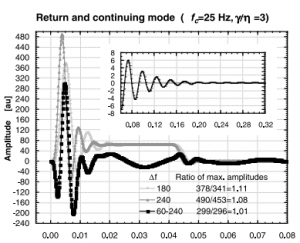J. Geophys. Res., 115, D19104 (2010)
doi:10.1029/2009JD013033.
A. Kułak a, Z. Nieckarz a, S. Zięba b
a) Institute of Physics, Jagiellonian University, Reymonta 4, 30-059, Kraków, Poland
b) Astronomical Observatory, Jagiellonian University, Orla 171, 30-244, Kraków, Poland
Download: http://europa.agu.org/
Abstract
Measurements of extremely low frequency (ELF) transients can be used to obtain model parameters and rates of the strong cloud‐to‐ground (CG) lightning discharges that generate them. In this study, we present an analytical description of a CG lightning discharge which takes into account both a return stroke and a continuing current. Using quasi‐TEM (q‐TEM) solutions for the Earth‐ionosphere waveguide for distances within the near zone we show that the ELF spectrum of transients strongly depends on the percentage contribution of the continuing current to the discharge process. It is supposed that during typical observational conditions the only parameter of an ELF transient that can be measured sufficiently accurately is the impulse amplitude. In relation to the observational conditions the consequences of the calibration of ELF receivers on the measured ELF impulse amplitude are discussed, particularly the role of antialias filters. It is demonstrated that measurements of the ELF transient amplitude at a known distance to the source allows the total dipole moment of the discharge to be calculated and allows contributions of the return stroke and continuing current to this process to be estimated. Furthermore, some techniques of the signal spectral filtration that enable independent measurements of the return and continuing phase of the discharge are discussed.
